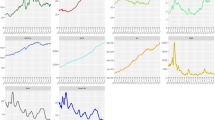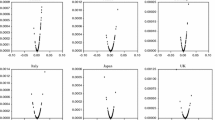Abstract
In this note we propose an alternative test specification for Basu’s (1997) time series measure of conservatism that is related to the threshold unit root test of Enders and Granger (1998). We argue that a regression of changes in earnings on the lagged levels—rather than lagged changes—, including an interaction term for negative values, has three conceptual advantages compared to the conventional setup: (1) a smooth, non-oscillating impulse-response pattern to an unexpected shock in earnings (2) a more efficient estimate of persistence in the long run and (3) it can be extended to higher order autoregressive processes. We apply both approaches to a common dataset of firms from the S&P500 index. We confirm the conventional finding that negative shocks are transitory and display stronger mean reversion than positive shocks. However, while most of the literature reports mixed evidence on positive shocks, we find clear evidence that positive shocks are transitory as well. In a Monte Carlo simulation we explain this finding by documenting that larger standard errors in the Basu specification can lead to incorrect inference when the decision between persistent and transitory shocks is close.


Similar content being viewed by others
Notes
See also Ball et al. (2010) for a recent discussion on the measurement of conservatism.
Apart from the time series approach, there are also other measures of conservatism. Widely used in literature, for instance, are earnings-returns based models and cash flow or accruals models (see Givoly et al. (2007) for an overview.) However, most of them are not uncontroversial. The estimation errors of accruals using the balance sheet approach have been pointed out by Collins and Hribar (2002) and the limitations of market-based approaches are discussed by Dietrich et al. (2007) and Beatty (2007).
With R squares of often <10 % in the Basu regression, the analysis of such unexpected changes clearly seems to be of high relevance to the overall analysis.
See also the theoretical underpinning given in Roychowdhury and Watts (2007).
See Sect. 6.
This specification is abstracting from serial correlation in the changes of accounting income. This lagged terms could be added to the regression as control variables, without changing the interpretation of the β1 coefficient. This would than be a full augmented Dickey and Fuller (1979) test specification as discussed in Hamilton (1994), Eq. 17.7.11., pp. 516–518. Luetkepohl and Kraetzig (2004) provide a more applied introduction to unit root testing.
Formally, this can be shown, when adding NI i,t−1 on both sides of the equation. As β1 + 1 is always positive, and between 0 and 1, any change in \(\varepsilon _{i,t}\) would smoothly disappear over time.
Note that the TAR model was not yet developed at the time of the original contribution of Basu (1997). We also do not fully adopt the TAR model, as in principle the Basu (1997) regression is a more natural setup for the research question of conservatism. While the TAR model tests whether positive and negative shocks, respectively, are persistent, the Basu (1997) setup is designed to test the significance of difference in the persistence between the two. This later question could only be answered in the Enders and Granger (1998) TAR model, when additionally performing a Wald test.
A recent analysis of S&P500 firms is also given in Saito (2012).
We also tested for Year and Firm/Year fixed effects. The results do not change quantitatively and are available upon request.
We also tried higher lag structures which remain insignificant, however.
A similar perspective is also taken in some papers that focus on the forecasting properties of net income. Albrecht et al. (1977), Finger (1994) and Gil-Alana and Peláez (2008) treat income as a stochastic ARIMA process. Finger (1994) is also quoted in the Basu (1997) and Ball and Shivakumar (2005) literature on the asymmetric timeliness, as Finger (1994) found that it is optimal to difference the data, due to the unit roots in the majority of cases. Note, however, that this was done purely for forecasting purposes. It does not follow from the Finger (1994) paper that the differencing of data is also appropriate for conducting tests of persistence. Finally, non-parametric measures of persistence are used, for instance, in Lipe and Kormendi (1994).
References
Albrecht WS, Lookabill LL, McKeown JC (1977) The time series properties of annual earnings. J Account Res 15(2):226–244
Ali A, Zarowin P (1992) Permanent versus transitory components of annual earnings and estimation error in earnings response coefficients. J Account Econ 15(2–3):249–264
Arellano M, Bond S (1991) Some tests of specification for panel data: Monte carlo evidence and an application to employment equations. Rev Econ Stud 58(2):277–297
Ball R, Shivakumar L (2005) Earnings quality in uk private firms: comparative loss recognition timeliness. J Account Econ 39(1):83–128
Ball R, Watts R (1972) Some time series properties of accounting income. J Financ 27(3):663–681
Ball R, Robin A, Wu JS (2003) Incentives versus standards: properties of accounting income in four east asian countries. J Account Econ 36(1–3):235–270
Ball R, Kothari S, Nikolaev V (2010) Econometrics of the basu asymmetric timeliness coefficient and accounting conservatism. Working Paper
Basu S (1995) Conservatism and the asymmetric timeliness of earnings. University of Rochester, Rochester
Basu S (1997) The conservatism principle and the asymmetric timeliness of earnings. J Account Econ 25(1):1–34
Beatty A (2007) Discussion of “asymmetric timeliness of earnings, market-to-book and conservatism in financial reporting”. J Account Econ 44(1–2):32–35
Brooks LD, Buckmaster DA (1976) Further evidence of the time series properties of accounting income. J Financ 31(5):1359–1373
Campbell JY, Mankiw NG (1987) Permanent and transitory components in macroeconomic fluctuations. Am Econ Rev 77(2):111–117
Cheung YW, Chinn M (1997) Further investigation of the uncertain unit root in gnp. J Bus Econ Stat 15(1):68–75
Collins DW, Hribar P (2002) Errors in estimating accruals: implications for empirical research. J Account Res 40(1):105–134
Dickey DA, Fuller WA (1979) Distribution of the estimators for autoregressive time series with a unit root. J Am Stat Assoc 74(366):427–431
Dickey DA, Fuller WA (1981) Likelihood ratio tests for autoregressive time series with a unit root. Econometrica 49(4):1057–1072
Dietrich JR, Muller KA, Riedl EJ (2007) Asymmetric timeliness tests of accounting conservatism. Rev Acc Stud 12(1):95–124
Enders W, Granger CWJ (1998) Unit-root tests and asymmetric adjustment with an example using the term structure of interest rates. J Bus Econ Stat 16(3):304–311
Fama EF, French KR (2000) Forecasting profitability and earnings. J Bus 73(2):161–176
Finger CA (1994) The ability of earnings to predict future earnings and cash flow. J Account Res 32(2):210–223
Gil-Alana LA, Peláez RF (2008) The persistence of earnings per share. Rev Quant Financ Acc 31(4):425–439
Givoly D, Hayn CK, Natarajan A (2007) Measuring reporting conservatism. Acc Rev 82(1):65–106
Hadi AS (1994) A modification of a method for the detection of outliers in multivariate samples. J R Stat Soc, B 56(2):393–396
Hamilton JD (1994) Time Series Analysis. Princeton University Press, Princeton
Hayn C (1995) The information content of losses. J Account Econ 20(2):125–153
Lipe R, Kormendi R (1994) Mean reversion in annual earnings and its implications for security valuation. Rev Quant Financ Acc 4(1):27–46
Luetkepohl H, Kraetzig M (2004) Applied Time Series Econometrics. Cambridge University Press, Cambridge
Nelson C, Plosser C (1982) Trends and random walks in macroeconomics time series: some evidence and implications. J Monet Econ 10(2):139–162
Ranciere R, Tornell A, Westermann F (2008) Systemic crises and growth. Quart J Econ 123(1):359–406
Roychowdhury S, Watts RL (2007) Asymmetric timeliness of earnings, market-to-book and conservatism in financial reporting. J Account Econ 44(1–2):2–31
Saito Y (2012) The demand for accounting information: young nasdaq listings versus s&p 500 nyse listings. Rev Quant Financ Acc 38(4):149–175
White H (1980) A heteroskedasticity-consistent covariance matrix estimator and a direct test for heteroskedasticity. Econometrica 48(4):817–838
Windmeijer F (2005) A finite sample correction for the variance of linear efficient two-step gmm estimators. J Econom 126(1):25–51
Author information
Authors and Affiliations
Corresponding author
Rights and permissions
About this article
Cite this article
Brauer, S., Westermann, F. On the time series measure of conservatism: a threshold autoregressive model. Rev Quant Finan Acc 41, 111–129 (2013). https://doi.org/10.1007/s11156-012-0302-3
Received:
Accepted:
Published:
Issue Date:
DOI: https://doi.org/10.1007/s11156-012-0302-3




